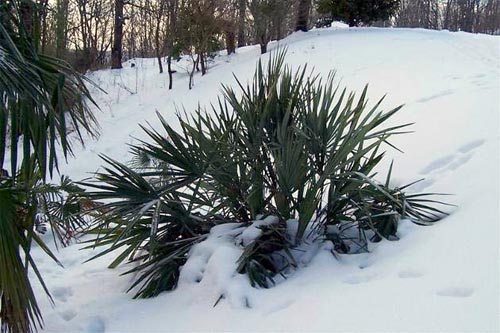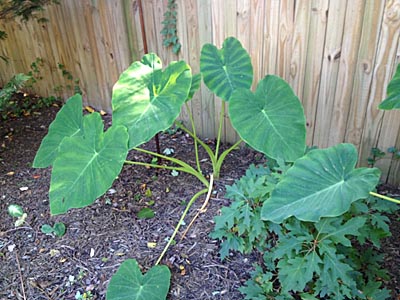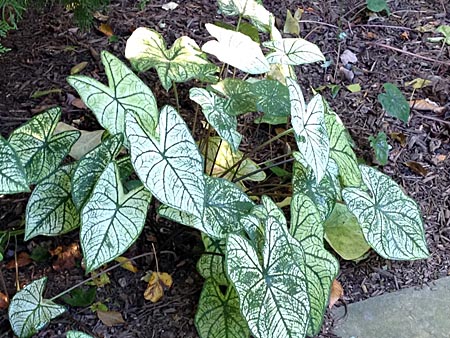Winter Care for Outdoor Tropical Plants
By Gil Medeiros, former Fairfax Master Gardener
I am a New Englander, born and raised. Nevertheless, I love the look of tropical plants in the landscape and have grown quite a few here in Northern Virginia. Unfortunately, by their nature, most tropical plants cannot survive our zone 7 winters – unless, as I have found, you take steps to protect them when cold temperatures hit.
There are thousands of tropical plants. Here are the ones that are most commonly grown in our area, along with my tried and true recommendations for protecting them come winter:

Needle Palm
True Palms
I learned the hard way that most palms can’t survive our winters without help. I grew Windmill palms (Trachycarpus fortunei) and Sabal ‘Birmingham’ palms in my backyard for three years, confident they were hardy here despite what the literature said. Reality crashed down upon my “trachies” and sabals during the first polar vortex winter. Temperatures fell to the low single digits — several times. That killed the little growing tips at the apex of the trunks. Goodbye palms.
I still grow Windmill palms along with a European Fan palm (Chamaerops humilis) and a Pindo palm (Butia capitata). These are in pots now and go into an unheated greenhouse for the winter. The greenhouse provides zone 8 conditions, and that’s just enough protection to keep them going.
You can overwinter a Windmill palm in the ground, but it will require constructing a mini-greenhouse around it using garden stakes and plastic sheeting. Make sure the plastic does not touch the plant. An electric heating cable or a string of old-fashioned, incandescent Christmas lights wrapped around the trunk of the palm may be necessary to protect it from single-digit temperatures.
To my knowledge, there is only one species of palm that can handle the winters here, and that’s Needle palm (Rhapidophyllum hystrix). My two have survived in the ground in my backyard for the past five years through the worst winter weather. An understory plant in the wild, Needle palm is a native of the southeastern U.S. Mine require no care except fertilization during the spring and early summer.
Sago palms (cycad family)
I have two Sagos in pots. They are too sensitive to plant in Northern Virginia ground. Mine go in the unheated greenhouse for the winter, but if you don’t have a greenhouse, setting them in a garage near a sunny window would work, too. The fronds might turn yellow, but in early spring, simply cut back the entire plant and wait a month or so. The Sago should grow all new fronds. Add a palm fertilizer to the pot in spring.

Musa Basjoo creates a tropical look
Bananas
One banana species, Musa Basjoo, is hardy in Northern Virginia — to the disbelief of almost everyone who sees the 15-foot-tall banana clumps in my backyard. After frost has killed off the banana trees, cut them down to the ground. I use a small limbing saw for this task, working in sections. The trunks are soft and water-filled and cut easily. Compost the trunks and leaves. Believe it or not, they will rot by next fall and make good compost. The trick to getting Musas through the winter is to pile a foot of mulch over the sawed-down trunks. I use inexpensive shredded hardwood mulch. In spite of the coldest winters and the biggest snowstorms, the Musas have returned spring after spring.
Alternatively, you can dig up the roots and store them in a cool, dry place for the winter. When I tried this approach a few years ago, some survived and some did not. When I tried overwintering a potted Musa in the cold greenhouse, it died. The simplest, most effective method for keeping Musas through the winter is to cut them level to the ground and to provide a deep layer of mulch.
People often ask whether Musas produce bananas. The answer is yes and no. Where the growing season is much longer than here, the Musas produce small, fibrous, inedible fruit. Here in Virginia my Musas have never even flowered.

Elephant Ears
Elephant Ears (Colocasia and Alocasia)
After the frost kills the elephant ear foliage, cut it off and compost it. Dig up the tubers, and spread them out for a few days either outside in the shade or inside a garage or basement. When they are dry, clean the soil from the tubers, and wrap them individually in newspapers. Put the wrapped tubers in a container or bag in a cool, dry place. Unwrap and inspect them in May, discarding any that show signs of rot. (Don’t be surprised if you lose a few to rot each winter.) Plant the tubers outside after the last threat of frost.
To accelerate the process, you can also start them inside in moist potting soil in a warm environment.
Although I have not tried it, I think it is possible to overwinter elephant ears in Northern Virginia by adding a thick layer of mulch similar to the process for bananas. I may try this experiment this winter.

Calladiums
Calladiums
Handle calladiums essentially the same way you handle elephant ears with one major exception. Pull the plants from the ground BEFORE the first frost. Calladiums are more sensitive to cold than elephant ears. Trim off the foliage; allow the tubers to dry, and wrap them in newspaper for a long winter’s nap. Awakening them in spring involves the same process as with the elephant ears.
Cannas
You can also treat cannas the same way as elephant ears. I have had a canna or two that I missed in the November dig-up emerge in the spring — albeit in a sheltered location.

Agave — beware of thorns
Agaves
Agaves are desert plants, not really tropicals. Nevertheless, they add an unusual appearance to the Northern Virginia garden. Most agaves can handle cold temperatures because deserts in their native range in the southwestern U.S. and Mexico can get very cold during winter nights. However, agaves cannot tolerate cold for extended periods, and they certainly do not tolerate soil that is cold and wet. For these reasons, they must occupy pots here in zone 7, and the pots must spend the winter in a cold greenhouse or a sunny spot in a garage or sunroom. Although some agaves can tolerate temperatures down to about 10 degrees F, they like a rapid rise in temperature during the day, as this is what they experience in the desert. The unheated greenhouse generally heats up to about 50 degrees on the coldest winter days.
Caution: Agaves have very sharp and nasty thorns. If you grow them, make sure you handle them with heavy leather gloves.
Resources
• Introduction to Cold-Hardy Tropicals for Virginia Landscapes, John A. Saia, Joseph W. Seamone and Susanne E.
Zilberfarb, Virginia Cooperative Extension
• Overwintering Tropical Plants, University of Maryland Extension
…updated 2024